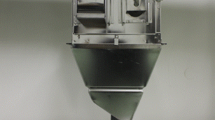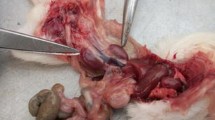Abstract
The present risk assessment study of fluoride salts was conducted by oral administration of three different doses of sodium and potassium fluorides (NaF, KF) and zinc fluoride tetrahydrate (ZnF2 •4H2O) to male Wistar rats. The rats were divided into control and nine experimental groups, to which oral injections of 0.5 mL distilled water and 0.5 mL of fluoride solutions, respectively, were given. The dosage of fluoride compounds was adjusted to contain 2.1 mg (low-dose group, LG), 4.3 mg (mid-dose group, MG), and 5.4 mg fluoride per 200 g rat body weight (high-dose group, HG) corresponding to 5, 10, and 12.5 % of LD50 values for NaF. The 24-h urine volume, N-acetyl-β-D-glucosaminidase (NAG) and creatinine clearance (Ccr) were measured as markers of possible acute renal impact. The levels of alanine aminotransferase (ALT) and aspartate aminotransferase (AST) were determined in serum samples as markers of acute hepatic impact. The levels of serum and urinary fluoride were determined to evaluate fluoride bioavailability. The results reveal that higher doses of NaF, KF, and ZnF2 induced renal damage as indicated by higher urinary NAG (p < 0.05 with ≥90th percentile of control). High doses of ZnF2 also induced a significant Ccr decrease (p < 0.05 with ≤10th percentile of control). Low doses of NaF and mid-doses of ZnF2 induced polyuria (p < 0.05 with ≥90th percentile of control) while medium doses of NaF and low doses of KF also induced liver damage, as indicated by a high level of AST (p < 0.05 with ≥90th percentile of control). These findings suggest that oral administration of fluoride is a potential, dose-dependent risk factor of renal tubular damage.

Similar content being viewed by others
Abbreviations
- LiF:
-
Lithium fluoride
- NaF:
-
Sodium fluoride
- KF:
-
Potassium fluoride
- MgF2 :
-
Magnesium fluoride
- CaF2 :
-
Calcium fluoride
- SrF2 :
-
Strontium fluoride
- BaF2 :
-
Barium fluoride
- ZnF2 :
-
Zinc fluoride tetrahydrate
- AlF3 :
-
Aluminum fluoride
- LaF3 :
-
Lanthanum fluoride
- CeF3 :
-
Cerium fluoride
- NdF3 :
-
Neodymium fluoride
- SmF3 :
-
Samarium fluoride
- GdF3 :
-
Gadolinium fluoride
- YF3 :
-
Yttrium fluoride
- YbF2 :
-
Ytterbium fluoride
References
Falcão A, Tenuta LM, Cury JA (2013) Fluoride gastrointestinal absorption from Na2FPO3/CaCO3- and NaF/SiO2-based toothpastes. Caries Res 47:226–233
Vogel GL, Schumacher GE, Chow LC, Tenuta LM (2015) Oral fluoride levels 1 h after use of a sodium fluoride rinse: effect of sodium lauryl sulfate. Caries Res 49:291–296
Dang H, Mailig M, Lalic G (2014) Mild copper-catalyzed fluorination of alkyl triflates with potassium fluoride. Angew Chem Int Ed Engl 53:6473–6476
Ye Y, Schimler SD, Hanley PS, Sanford MS (2013) Cu(OTf)2-mediated fluorination of aryltrifluoroborates with potassium fluoride. J Am Chem Soc 135:16292–16295
Wang FH, Yang CF, Lee YH (2014) Deposition of F-doped ZnO transparent thin films using ZnF2-doped ZnO target under different sputtering substrate temperatures. Nanoscale Res Lett 9:97
Kono K, Yoshida Y, Watanabe M, Tanioka Y, Dote T, Orita Y, et al. (1992) An experimental study on the treatment of hydrofluoric acid burns. Arch Environ Contam Toxicol 22:414–418
Kono K, Watanabe T, Dote T, Usuda K, Nishiura H, Tagawa T, et al. (2000) Successful treatments of lung injury and skin burn due to hydrofluoric acid exposure. Int Arch Occup Environ Health 73(Suppl):S93–S97
Dote T, Kono K, Usuda K, Shimizu H, Kawasaki T, Dote E (2003) Lethal inhalation exposure during maintenance operation of a hydrogen fluoride liquefying tank. Toxicol Ind Health 19:51–54
Takase I, Kono K, Tamura A, Nishio H, Dote T, Suzuki K (2004) Fatality due to acute fluoride poisoning in the workplace. Legal Med 6:197–200
Kono K, Usuda K, Dote T, Shimizu H, Yamadori E, Shimahara M (2008) Hogenakkal water ssupply and fluorosis mitigation projectin the Indian state of Tamil Nadu Report of a preliminary survey. Bull OMC 54:71–77
Young N, Newton J, Morris J, Morris J, Langford J, Iloya J, et al. (2015) Community water fluoridation and health outcomes in England: a cross-sectional study. Community Dent Oral Epidemiol 43:550–559
Lech T (2011) Fatal cases of acute suicidal sodium and accidental zinc fluorosilicate poisoning. review of acute intoxications due to fluoride compounds. Forensic Sci Int 206:e20–e24
Wiese J, Klug E (1989) Poisoning with a wood preservative. Beitr Gerichtl Med 47:103–106
Spoor NL (1968) The toxicity of lithium fluoride. Ann Occup Hyg 11:23–25
Usuda K, Kono R, Ueno T, Ito Y, Dote T, Yokoyama H, et al. (2014) Risk assessment visualization of rubidium compounds: comparison of renal and hepatic toxicities, in vivo. Biol Trace Elem Res 159:263–268
Usuda K, Kono R, Ueno T, Ito Y, Dote T, Yokoyama H, et al. (2015) Comparison of the biological impacts of the fluoride compounds by graphical risk visualization map technique. Biol Trace Elem Res 167:84–90
Dumbravă V, Iacob V-S (2013) Using probability-impact matrix in analysis and risk assessment projects. J Knowl Manag, Econ Inf Technol Spec Issue December 2013:76–96
Conine DL, Yum M, Martz RC, Stookey GK, Muhler JC, Forney RB (1975) Toxicity of sodium pentafluorostannite, a new anticariogenic agent. I. Comparison of the acute toxicity of sodium pentafluorostannite, sodium fluoride, and stannous chloride in mice and/or rats. Toxicol Appl Pharmacol 33:21–26
Usuda K, Kono K, Shimbo Y, Fujihara M, Fujimoto K, Kawano A, et al. (2007) Urinary fluoride reference values determined by a fluoride ion selective electrode. Biol Trace Elem Res 119:27–34
Kumagai S, Kurumatani N, Arimoto A, Ichihara G (2013) Cholangiocarcinoma among offset colour proof-printing workers exposed to 1,2-dichloropropane and/or dichloromethane. Occup Environ Med 70:508–510
Rush GF, Willis LR (1982) Renal tubular effects of sodium fluoride. J Pharmacol Exp Ther 223:275–279
Moss DW, Henderson AR (1996) Enzymes. In: Tietz NW (ed) Tietz fundamentals of clinical chemistry, 4th edn. W. B. Saunders Company, Philadelphia, p 283–335
Kono K, Yoshida Y, Watanabe M, Orita Y, Dote T, Bessho Y (1993) Urine, serum and hair monitoring of hydrofluoric acid workers. Int Arch Occup Environ Health 65(1 Suppl):S95–S98
Kono K, Yoshida Y, Watanabe M, Tanioka Y, Orita Y, Dote T, et al. (1992) Serum fluoride as an indicator of occupational hydrofluoric acid exposure. Int Arch Occup Environ Health 64:343–346
Acknowledgments
The Japan Society for the Promotion of Science supported this study through a Grant-in-Aid for Scientific Research (JSPS KAKENHI) for scientific research (C) Number 25460822.
Author information
Authors and Affiliations
Corresponding author
Ethics declarations
All animal experiments were conducted by contract with KAC Co., Ltd. (Shiga, Japan) in accordance with their Institutional Guidelines for the Care and Use of Laboratory Animals, the Japanese Government Animal Protection and Management Law (No. 105), and the Japanese Government Notification on Feeding and Safekeeping of Animals (No. 6).
Rights and permissions
About this article
Cite this article
Usuda, K., Ueno, T., Ito, Y. et al. Risk Assessment Study of Fluoride Salts: Probability-Impact Matrix of Renal and Hepatic Toxicity Markers. Biol Trace Elem Res 173, 154–160 (2016). https://doi.org/10.1007/s12011-016-0644-0
Received:
Accepted:
Published:
Issue Date:
DOI: https://doi.org/10.1007/s12011-016-0644-0




